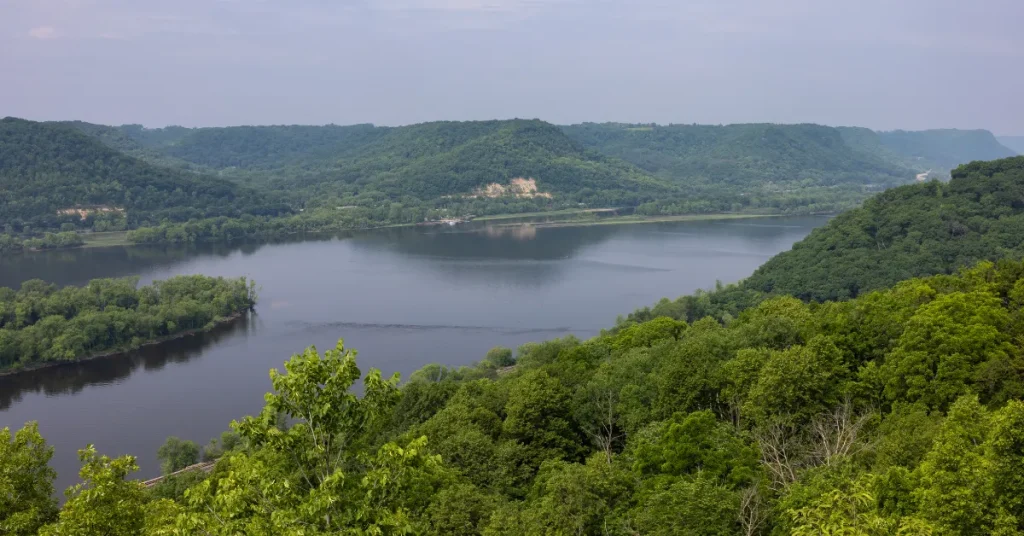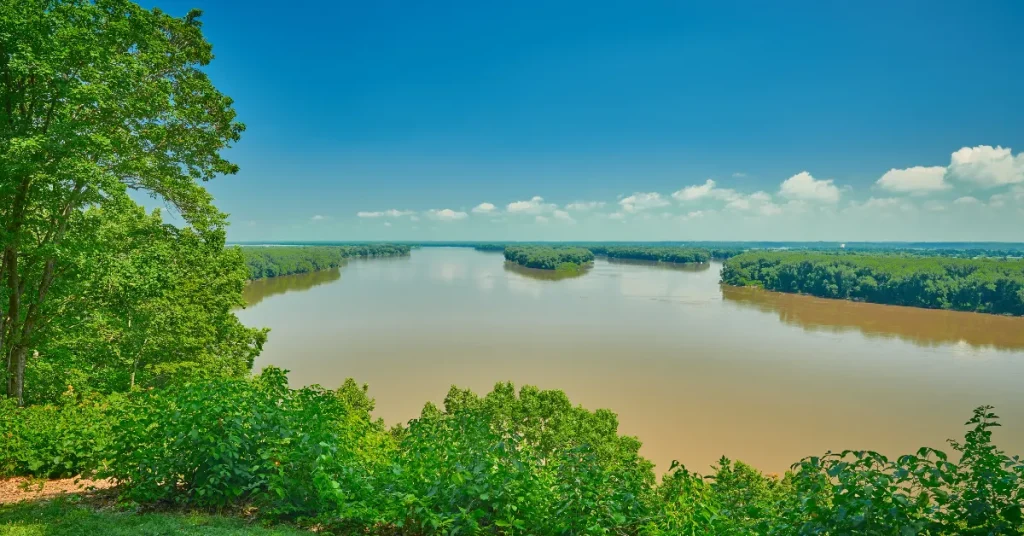The Mississippi River reaches a maximum depth of over 200 feet near Algiers Point in New Orleans. The average depth of the river is about 9 to 12 feet.
The Mississippi River, North America’s second-longest river, plays a vital role in the ecology, economy, and history of the United States. Originating from Lake Itasca in Minnesota, it flows for over 2,300 miles before emptying into the Gulf of Mexico.
Its waters traverse diverse landscapes, supporting agriculture, transportation, and habitats for numerous wildlife species.
The river’s depth varies considerably along its course, influenced by natural and man-made factors, making it navigable for large vessels in some sections while shallower in others.
Understanding the Mississippi’s depth is crucial for the industries relying on its waterways, as well as for managing flood risks and maintaining ecological balance.

Plunging Into The Mississippi’s Depths
The Mississippi River, a name that stirs images of steamboats and rich history, winds its way through the heart of America.
Its depths hold secrets, shipwrecks, and ecosystems. But just how deep does this iconic river plunge? Let’s uncover the mysteries beneath the waters of this mighty river.
The Varied Depths Of The Mighty River
A river of many faces, the Mississippi’s depth is not one-size-fits-all — it changes from place to place. Conditions such as location, riverbed composition, and water flow give the Mississippi a range of depths.
- Shallow Waters: In its upper reaches, the depth can be as little as three feet.
- Mid-River Measurements: The riverbed dips and rises, averaging about nine to twelve feet in depth.
- Deeper Channels: Near major urban centers and shipping routes, depths can reach up to 100 feet deep!
Measuring Techniques And Challenges
Figuring out how deep the river runs involves some high-tech methods and a few natural obstacles.
| Technique | Usage | Challenges |
| Sonar | Uses sound waves to determine depths | Can be hindered by debris and muddy waters |
| GPS Mapping | Helps to create detailed depth charts | Requires accurate calibration for precise readings |
| Manual Gauging | A traditional method using a marked line | Time-consuming and affected by currents |
Mississippi’s Geographical Tapestry

The Mississippi River runs like a thread sewing together the fabric of America’s heartland. Known as the Mississippi’s Geographical Tapestry, this massive waterway weaves through diverse landscapes.
It grants vitality to ecosystems and cities alike. Its depth is as mysterious as its winding path.
From Source To Sea: A Journey
The Mississippi River springs to life at Lake Itasca in Minnesota. Here, you can almost leap across its narrow banks. As it snakes southward, the river gathers strength from numerous tributaries, growing wider and deeper.
- Lake Itasca, Minnesota: The source of the river
- Gulf of Mexico: The endpoint of the river’s 2,340-mile journey
Depth Variation Along The Course
The depth of the Mississippi River is not the same everywhere. It shifts and changes, influenced by the surrounding geography and human intervention.
| Location | Average Depth (Feet) | Notes |
| Upper Mississippi | 3-20 | Shallow with many natural dams |
| Middle Mississippi | 12-30 | Depth increases with channeling |
| Lower Mississippi | 30-200 | Deepest near New Orleans |
In regions like New Orleans, the river plunges to its deepest. Ships travel these depths like submarines exploring an underwater world. Yet, where the river meets the sea, its depth becomes ever so elusive, mingling with ocean waters.
Human Impact On River Depth
The depth of the mighty Mississippi River tells a story of natural phenomena and human influence. Humans have left an indelible mark on the river’s depth, altering its course and flow. This section explores how their actions impact the Mississippi’s depth.
Engineering Projects And Depth Alterations
Over the years, humans have executed numerous engineering feats to manage the Mississippi River for navigation and flood control. These alterations significantly affect the river’s depth.
- Levees: Tall embankments, called levees, keep the river in a narrow channel, which can deepen the riverbed due to concentrated flow.
- Dams and Locks: These structures control water levels, sometimes raising river depth for better navigation.
- Dredging: Regular removal of sediment ensures deeper channels for large vessels, artificially maintaining depth.
Conservation Efforts And Natural Sedimentation
Conservation efforts aim to balance human needs with the natural state of the Mississippi. One key aspect of these initiatives is managing sediment.
| Action | Impact on Depth |
| Restoring Wetlands | Helps trap sediment, preventing excessive deepening. |
| Reforestation | Tree roots stabilize banks, reducing soil erosion into the river. |
| Floodplain Reconnection | Allows natural flood cycles, distributing sediment evenly. |
As these efforts encourage the natural sedimentation process, they can counteract some of the depth changes caused by human engineering projects. The delicate balance between conservation and alteration dictates the Mississippi’s depth and health.
The River’s Inhabitants And Depth
The Mississippi River, a natural marvel, teems with diverse life forms. From tiny fish to large amphibians, a rainbow of species call this mighty river home.
Depth plays a critical role in the kind of creatures you can find at different points along the river. Let’s dive into the underwater world of the Mississippi to discover how aquatic life adapts to its depths and the unique habitats each level of depth provides.
Aquatic Life Adjusting To Depths
Life in the Mississippi River is abundant and varied. Species are beautifully adapted to different water depths.
At shallower levels, sunlight nurtures plant life, which in turn supports a range of fish and insects. In deeper waters, where light fades, creatures like the pallid sturgeon prevail in the dark.
- Sunfish and catfish thrive in less than 20 feet of water.
- Deeper areas, often exceeding 100 feet, are home to larger fish and mollusks.
Depth-based Ecosystems And Habitats
The river’s depth plays a pivotal role in crafting unique ecosystems. Shallow areas, for instance, foster lush plant growth.
These zones create nurseries for juvenile fish and feeding grounds for birds. Deeper sections become mysterious realms where specialized species flourish.
| Depth (feet) | Habitat Characteristics | Common Inhabitants |
| <1-20 | Muddy substrates, high sunlight | Bass, Crayfish |
| 20-100 | Diminished light, cooler temperatures | Drum Fish, Sturgeon |
| 100+ | Dark, cold, high pressure | Specialized invertebrates |
At each depth, unique conditions define the living environment. Creatures thus display remarkable adaptations to survive and thrive where they live.
Mississippi‘s The Underwater Secrets

The Mississippi River, a cradle of American history, hides its secrets beneath the surface. The riverbed tells tales of long-lost civilizations, bustling trade routes, and even community life that once thrived on its banks.
Diving into these underwater secrets uncovers artifacts and geological features, providing a window to America’s past and a key to understanding future environmental shifts.
Historical Artifacts Submerged
Within the Mississippi’s murky depths lie countless historical artifacts. As the river carved its path through time, it swallowed pieces of human history.
From ancient Native American tools to sunken steamboats from the golden age of river trade, the riverbed is a submerged museum waiting to be explored.
- Civil War relics, hidden by time and silt
- Commerce remnants like coins and trade goods from bygone eras
- Shipwreck remnants, offering glimpses into perilous river journeys
Current Research And Future Explorations
Research teams use modern technology to capture the Mississippi’s secrets. With sonar imaging and robotic submersibles, they traverse the river’s depths.
Scientists aim to map the unseen terrain and uncover more hidden artifacts. They also monitor environmental changes affecting the river’s health.
Current research initiatives include:
- Mapping underwater landscapes to understand sediment movement
- Studying submerged habitats for conservation efforts
- Unlocking historical trade routes through artifact analysis
The future holds more advanced explorations with hopes to preserve these treasures. Additionally, revealing more about the waterway that helped shape a nation’s destiny.
As technology improves, expect even deeper dives and more startling revelations from the heart of the mighty Mississippi.
FAQs About How Deep Is The Mississippi
What Is The Average Depth Of Mississippi River?
The Mississippi River’s average depth is around 9 to 12 feet. However, it can reach up to 200 feet deep at its deepest point near Algiers Point in New Orleans.
How Deep Does The Mississippi River Get?
At its deepest point near New Orleans, the Mississippi River reaches depths of about 200 feet. This deep section is an exception to the generally shallow river.
Where Is The Mississippi River Most Shallow?
The Mississippi River’s upper stretch near its source at Lake Itasca is notably shallow, averaging less than 3 feet deep. This region contrasts with the river’s deeper downstream sections.
Does The Depth Of Mississippi River Change?
Yes, the depth of the Mississippi River fluctuates due to factors like seasonal precipitation, flooding, and dredging efforts to maintain navigability for shipping.
Conclusion
Navigating the depths of the mighty Mississippi reveals a river as complex as it is venerable.
With its myriad channels and ever-changing beds, it demands respect from those charting its waters. Understanding its depth is key to appreciating the river’s role in ecology, commerce, and history.
Let’s continue to explore and protect this iconic waterway for future generations to marvel at and learn from.
Resources:
1. https://www.nps.gov/locations/lowermsdeltaregion/history-and-culture-of-the-mississippi-delta-region.htm
